A comparative overview of the methods for fixing the skirting board: liquid nails, screws or clips?
Plinth installation - the traditional completion of the device or floor repair. Shaped planks made of plastic, MDF, wood hide technological gaps, unattractive elements, communications if they are laid in special skirting niches. Plinths are mounted in different ways to one of two surfaces: either to the floor or to the walls. The choice of the best option depends on the type of flooring, on the material of which the baseboard is made, on the preferred technology.
Content
Types of skirting boards and features of their fasteners
To complete the finish of the floor, you can now purchase both traditional wood planks and more economical, easy-to-install plastic or MDF products.
Solid wood skirting board
Wood goes well with any type of flooring, but because of its high cost it is mainly used for finishing parquet and parquet flooring. There are the usual triangular wooden planks of a plinth made of oak, alder, larch, etc. on the market. There are products manufactured according to European standards with devices for installing cable wiring. Wooden slats should not be installed if the walls are not aligned well.
Important. Before fixing baseboards from the massif, their surface must be treated with a decorative and protective composition: varnish, oil, etc.
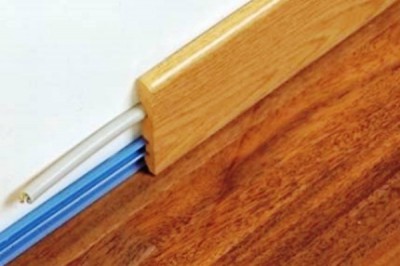
The wooden plinth fastening is preceded by cutting elements according to the dimensions accurately taken at the object:
Baseboards with MDF base
These are slats covered with a laminated film, foil or veneer. By decorative indicators, they are not inferior to products made of valuable wood, but they are significantly cheaper. MDF is a fragile material, with unskillful hands it is no wonder to spoil it. Therefore, basically fixing the MDF baseboard is made to the walls with the help of special hook-shaped brackets, on which the slats are then worn.
For the design of end sections and corners, “corners” and end caps are supplied with skirting boards. This design solution attracts with the ability to easily remove the skirting boards and mount them again after repairing the floor.
Practical plastic baseboard
Durable PVC strips are not afraid of temperature fluctuations, intensive wet processing, sun rays. The polymer profile created according to the prototype of a wooden skirting board is perfectly suitable for installing a floor with laminate, carpet, linoleum, but it does not look good in combination with parquet.

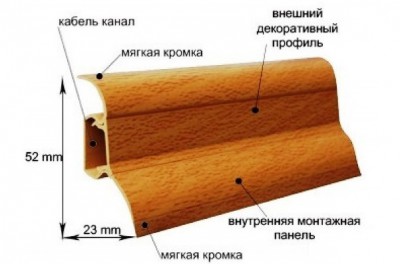
PVC slats designed to work together with carpet or linoleum are equipped with grooves for fixing the edge of the floor covering. Lightweight strips provide the ability to perform simple and labor-saving mounting of the skirting board on liquid nails. But to dismantle a profile firmly fixed around the perimeter before the next repair will be problematic.
Among the priorities of plastic strips include the presence of channels for cable wiring, plugs and devices for forming a neat angle. It does not need to be cut and the flexible profile can be pressed firmly against an insufficiently aligned wall.
Where is it better to fix it - to the floor or to the wall?
The presence of two perpendicular planes determines two options for fixing the floor plinth. The simplest and easiest way would be a natural preference. The easiest way is to attach this decoration element to the surface, into which fasteners will be included with less labor:
- In houses made of timber with concrete floors and with cement screed, it is recommended to prefer fixing the baseboard to the wall;
- In houses made of foam concrete and brick with a wooden floor, it is more reasonable to “drive” dowels or nails into it.
In order to fix the plinth to the floor with a concrete screed, you will first have to drill holes for plastic dowels with a puncher to the walls of foam concrete. The step of arranging points for installing the fasteners determines the type and degree of unevenness of the base, the geometric parameters of the rails. The most common distance between fixation points, both of the plinth itself and of planks or clips for mounting plastic battens, is at least 30, and at most 40 cm.
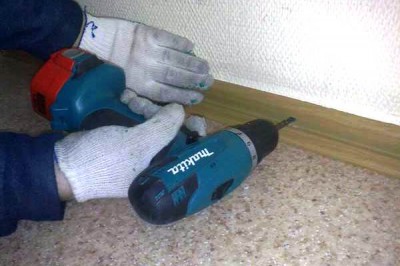
Attention. On the walls finished or only leveled with plaster, on the partitions constructed with the help of drywall, on the constructions revetted with a soft finishing stone, on a chipboard the skirting board will not be firmly held. In such cases, it is recommended to choose the floor as the basis for fixing.
If, for any reason, fixing the baseboard to drywall or to a chipboard panel is the only possible option, to fix it you need to purchase special self-tapping screws designed to work in this material, or finishing nails with a zinc coating.
It is generally desirable to place the attachment points on the metal elements of the frame, if it was used as a structural support.
Overview of methods for fixing the baseboard
Liquid Nails
The simplest, quickest, but irrational from the point of view of subsequent alterations is the use of a binder composition "liquid nails". True, for the installation of veneered brittle skirting is one of the rational methods. The whole technology includes two processes: treated with adhesive from the rear, fixed on the floor or wall.
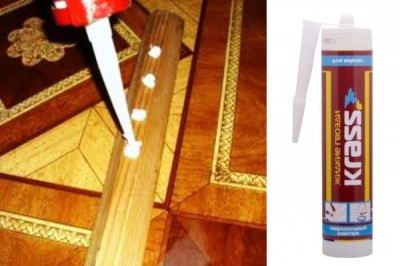
Clips and brackets for fixing
A skirting board made of MDF or plastic with internal devices for fixing to the supporting strip or to the clip does not have holes on the surface of the screws. The hidden installation method involves fixing only the supporting element to the base, on which the rails are then hung.
For mounting the inside of the structure:
- place the first fastener on the floor 5 cm from the corner starting from which the installation will be carried out clockwise, press the clip firmly against the wall, mark through the hole a place for drilling holes for the dowels;
- with a step of 50 cm, holes are marked and then drilled in the wall, the diameter of the drill determines the size of the dowels supplied with the rails;
- using the fasteners included in the kit, devices of the hidden fastening system are mounted;
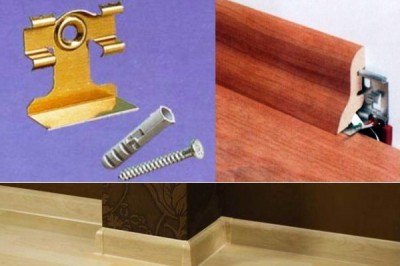
Note. To equip a room with poorly aligned walls, the step of the location of the fastener points must be reduced.
The final installation of skirting boards on clips or trims is done with a simple click.
Mounting method with dowels and screws
Begin the installation with the markup. The starting point is the angle of the length of the wall. Before marking, the plastic baseboard is equipped with a corner accessory. The edge of the wooden battens is sawn off at an angle of 45º.
- To mark the position of the first point from the corner, you need to retreat 5 or 6 cm.
- The baseboard must be pressed firmly to both mating surfaces. Further, a hole is drilled through the outlined first point so that a mark from the drill remains on the wall. Thin walls of plastic skirting boards can be punctured with a simple awl for marking.
- The rail is pushed away from the wall.
- Holes are formed in the walls or in the floor with a puncher for subsequent plugging of dowels into them.
- Then the dowels are mounted, the baseboard is applied according to the marking, the screws are inserted and twisted into the holes on top of the rail attached to the wall.
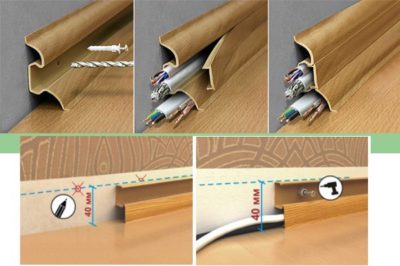
Tip. A screw can not be screwed into a flexible plastic skirting board to the end if the screwing results in a concave segment. Half the turn you need to unscrew the screw. In general, it is not necessary to screw the screws too hard on top of the plastic rails, cracks may appear from excess effort.
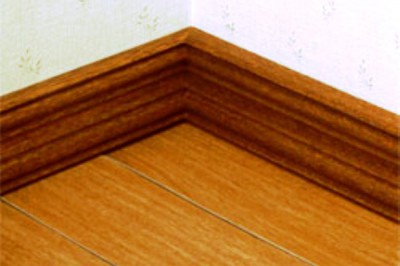
The next steps are similar to the beginning. After installing the elements around the entire perimeter of the cap, the screws can be masked with a wax pencil, matched to the color of the baseboard. Defects resulting from sawing wooden planks can be hidden with a primer.
The right choice is a great result.
The described methods for fixing the skirting board will help you choose the appropriate option for completing the finishing touch. Provided that the type of baseboard matches the technology of its installation, you do not have to redo the work, again spend money on the purchase of material. The information will tell you how to navigate in the questions about the preferred surface for fixing the baseboard, how to choose planks that are in harmony with the floor covering. In conclusion, we suggest you familiarize yourself with another “unusual” installation method:

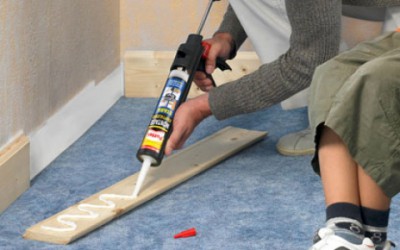
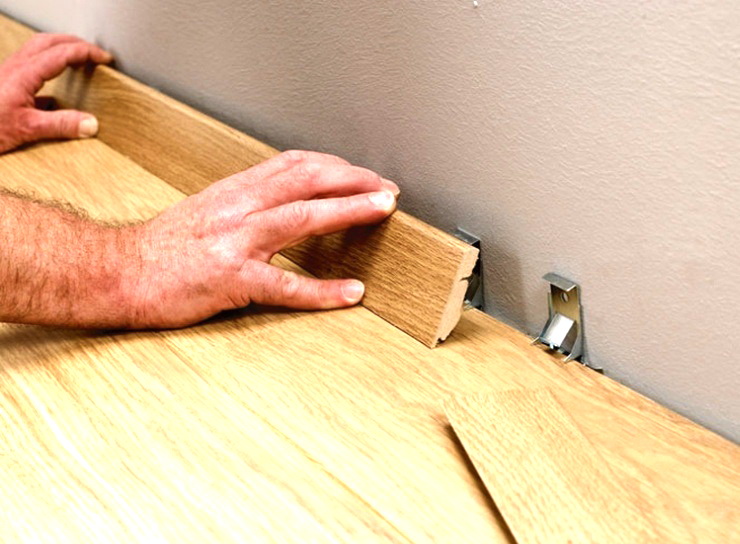
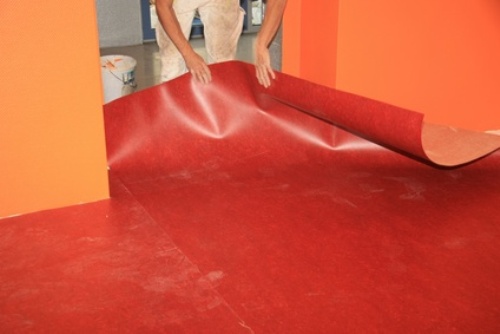
5 comments